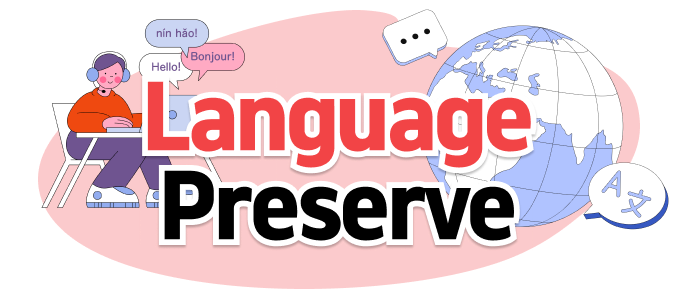A Tale of Identity and Visibility in Endangered Languages
The world today faces a pressing issue with its immense linguistic diversity. Of the approximately 7,000 languages currently spoken, only about 35% are considered safe, according to Glottolog estimates. The rest face varying degrees of endangerment, some languishing at the brink of extinction. The reality is stark: for some languages, it may, unfortunately, be too late to save them.
Research underscores the profound benefits of preserving linguistic diversity, which contributes to enhancing individual and community well-being, supporting minority rights, and retaining access to invaluable indigenous knowledge crucial for environmental protection efforts. The challenge, however, lies in developing effective strategies to preserve these endangered languages and ensure their transmission to future generations.
The Power of Writing in Language Preservation
One of the most potent tools in the battle to maintain and revitalize languages at risk of disappearing is writing. Documenting a language introduces numerous advantages, such as enabling the creation of educational materials in print and online formats, as well as facilitating long-distance communication. More broadly, writing serves to make a language both visible and audible, offering a significant mode of expressing cultural identity.
However, an ironic challenge presents itself: the languages most in need of preservation are typically minoritized and endangered, and often lack a standardized writing system. While some may possess their unique scripts, these are generally used by only a small group and face difficulty in achieving wider acceptance. According to the Endangered Alphabets project, 85-90% of the world's unique writing systems are at risk of vanishing.
The question arises: how should we go about writing a language effectively? Although there are established linguistic principles—such as ensuring that all distinctive sounds, or phonemes, of a language can be represented—there remains no universal strategy for writing a language. This is where lessons from history become invaluable.
Ancient Insights from Cypriot Syllabic Writing
The study of ancient and medieval languages, especially those extensively documented, allows us to observe their evolution in terms of usage and the corresponding writing systems. We can trace periods of linguistic vitality alongside periods of decline, analyzing how languages were documented, the chosen writing systems, and their proliferation across societies.
The Visual Interactions in Early Writing Systems (VIEWS) project delves into the aesthetics and perception of written scripts. This involves questioning why certain shapes or styles are chosen and how text is displayed and read. By using case studies from ancient cultures across the Americas, the Mediterranean, Western Asia, and Northern Africa, researchers seek to uncover the dynamics that have shaped writing.
A particularly enlightening case is that of ancient Cyprus, where inhabitants used an old syllabic script to write their Greek dialect throughout the first millennium BCE. This syllabic system, featuring approximately 55 characters, was markedly distinct from neighboring contemporary scripts. However, it was not a perfect fit: certain Greek phonemes were indistinguishable, and it was cumbersome to document consonant clusters and terminal consonants, common features in Greek, due to the nature of the syllables represented.
Despite these challenges, ancient Cypriots cherished their writing system. It was not only adopted by royal dynasties for inscriptions but was also widely used across religious, administrative, funerary, and everyday contexts. Unique local styles evolved, including variations in writing direction, and graffiti became commonplace. There is evidence suggesting diverse social and gender engagement with this writing system, even extending to foreign inscriptions by tourists and mercenaries in distant Egypt, such as on the Great Pyramid.
The Success Factors of a Writing System
The Cypriot case reveals key attributes contributing to a writing system's success. Remarkably, users prioritized the distinctive appearance of their script over precise linguistic accuracy, associating it with their cultural and linguistic identity. The widespread social visibility of their script—through prominent inscriptions in cities and religious sites, and its use on common items like pottery and currency—also played a critical role.
In the contemporary setting, minority language communities are faced with significant decisions about how to document their languages. There is no universal solution: some may opt to use the script of a dominant language to elevate their status, while others might eschew colonial systems in favor of traditional or uniquely devised scripts.
Ultimately, these choices must reflect the specific needs and circumstances of each language community. Insights from the past, such as those drawn from Cypriot Syllabic writing, suggest that communities should perhaps focus less on achieving perfect linguistic representation and more on ensuring the written language is a visible and resonant symbol of cultural identity.
The Endangered Writing Network: A New Collaborative Initiative
In response to these challenges, the VIEWS project has embarked on an exciting initiative known as the Endangered Writing Network. This project seeks to bring together a diverse array of participants—academics, linguists, activists, typographers, artists, and crucially, members of minority language groups—with the goal of conserving linguistic and script diversity worldwide. Drawing from research into historical writing systems like that of the ancient Cypriots, the initiative aims to contribute innovative approaches to the ongoing endeavors of language preservation.
In a world increasingly aware of its interconnectedness, the lessons drawn from the past and the collaborative spirits of today offer hope and pathways to sustain the rich tapestry of human language and written expression for generations to come.
출처 : Original Source

